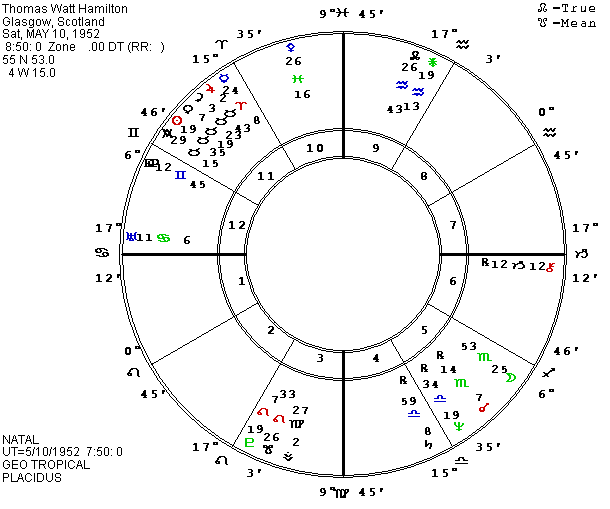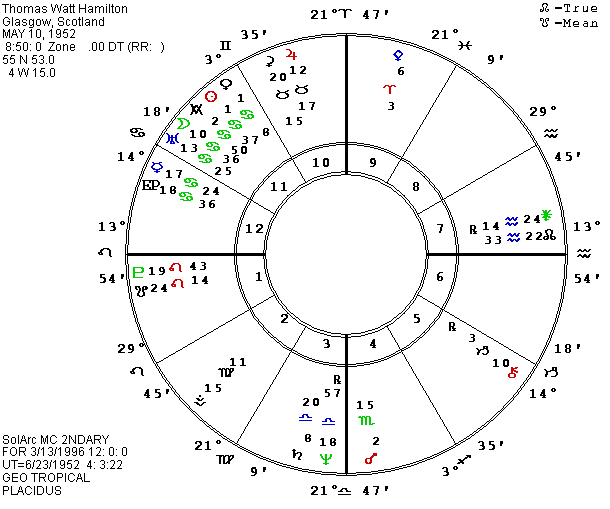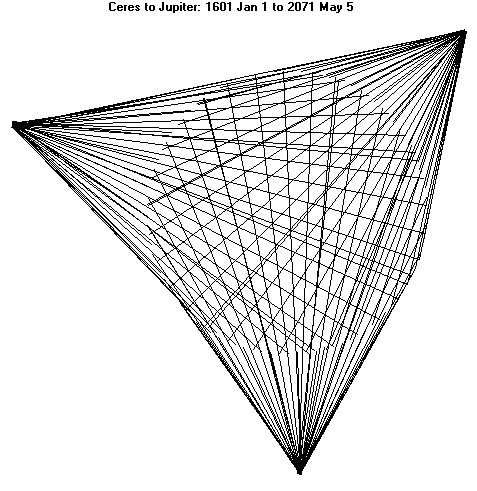Thomas Watt Hamilton
Zip Dobyns
Studying Hamilton's chart may seem morbid, but we can sometimes learn a lot about astrology and human nature by analyzing extreme individuals. Hamilton is the man who shot over 30 children in a school in Scotland and then committed suicide. His data comes from an astrologer in Scotland who obtained his birth certificate. Hamilton was born on May 10, 1952 at 8:50 A.M. GDT in Glasgow, Scotland. He had tutored children, mostly young boys, in gymnastics, but his excessive interest in taking photographs of them with minimal clothing made parents suspicious and he was barred from being a boy scout leader. He had become increasingly more isolated in the society, and on the morning of March 13, 1996, he turned a machine gun on mostly five-year old children in the school gym before shooting himself.

At first glance, Hamilton's chart looks potentially quite positive. His major stellium is in the sign of Taurus in the house of Aquarius. The latter is highly appropriate for a teacher who works with the children of others. Letter five in our astrological alphabet shows our ability to procreate our own children among other forms of creativity, so its polar opposite, letter eleven, can be the children of others. Also, as an air side of life, Uranus, Aquarius, and the eleventh house are connected to the conscious side of the mind, to our ability to learn and communicate. The lunar nodes in Leo-Aquarius and in the Gemini-Sagittarius houses are also a classic signature for the perpetual student and natural teacher. Cancer rising reinforces the attraction to home and family, in addition to Uranus in Cancer and Pluto and a node in Leo. Hamilton also had factors in the fourth and fifth houses, especially the Moon in the fifth. Uranus rising near the Ascendant, the East Point in Gemini, and Vesta in Virgo in the third house offer additional support for intelligence and the urge to share knowledge with others. Pallas in Pisces in the tenth house fits an idealistic career of service to others, often as a consultant or counselor. Chiron in the sixth house also fits an idealistic career which could involve healing or giving knowledge to others. Chiron seems to carry all of the Jupiter potentials, including a love of sports and other physical skills, which makes gymnastics a suitable choice for a career.
So, where did he go wrong and could we have suspected it before the shocking event?
Hamilton's primary conflict aspects involve fixed signs and houses and planets. What might be called a T-square from the Sun to Juno and Pluto is, in fact, a fixed grand cross. Pluto and Juno bring in the Scorpio principle with their own nature, the Sun and Leo are both part of the configuration, Juno is in Aquarius and the eleventh house carries the same meaning, and the Sun brings in Taurus which is backed up by four more factors in the sign. When we check the planetary nodes, Hamilton also had the south node of Mars in 19 Scorpio in the Leo house to fill in that fourth corner. Hamilton's Moon in Scorpio was also in an exact T-square to its own nodes in Leo-Aquarius and the Antivertex, an auxiliary Ascendant, was widely involved to fill the fourth corner of a second fixed grand cross. Venus in its own sign of Taurus was also exactly opposite Mars in Scorpio and their placement in the Leo-Aquarius houses gives the equivalent of a third fixed grand cross. Hamilton's chart is a good example of how you can see a theme when you know that the planets, houses, and signs represent the same twelve basic principles.
Of course, the other qualities are also present, though the fixed factors dominate the chart. Saturn, Uranus, and Chiron form a T-square in cardinal signs but partly mutable houses. The Ascendant also squares Neptune in cardinal signs. Mercury in Aries octile the MC, which is equivalent to Saturn, is also a cardinal statement, with the personal will and power of Aries confronting the limits of personal power symbolized by the MC. Both the cardinal and the fixed dilemmas deal with the same issue: the ability to handle power and to share the world with other people. To handle either of these dilemmas, we can cooperate with others, compete in healthy, game-playing ways, and help others. Healthy competition plays by socially acceptable rules and lets us win some and lose some with both sides gaining skill and enjoying the contest. When the contest becomes a matter of life and death or when one side wins all the time, it is obviously no longer healthy or competitive.
Individuals whose charts emphasize the cardinal sides of life tend to produce overt changes in their lives. They may change personal action, home, relationships, and career or some other status in the society. Individuals with more emphasis on the fixed sides of life may stay in a stalemate or impasse for a considerable time, but when they do break, it is often explosively. Fixity is especially associated with pleasures, sensuality, possessions, and intense passion. Individuals with a fixed emphasis need healthy outlets for their sensuality. They need to share pleasure. Swings are common between excessive sensual indulgence versus denial and asceticism until they develop the capacity for moderation. People with a fixed emphasis are helped by having a variety of forms of sensual satisfaction, including artistic expression. Photography can be a good outlet, but Hamilton's focus on nude or nearly nude young boys for his hobby was upsetting to both the boys and their parents. He is not known to have had any intimate relationships with peers, and his chart shows an intense need for that. When any basic drive is totally blocked, especially the fixed or cardinal drives which involve power, it turns destructive. The individual may turn it against himself and become ill, or he may attract attacks from others, or he may lash out against the world in some way.
Hamilton's repeated conflict aspects involving fixed planets, houses, and signs, could have simply manifested as the freedom-closeness dilemma which is so common in the western, industrialized world, but his isolation, especially being increasingly cut-off from the children he wanted to teach, was eventually devastating to his self-esteem. It is still hard to fathom why he turned against the children rather than the adults who increasingly ostracized him, but his progressions when he snapped certainly showed the potential for an emotional crisis.

Hamilton had experienced a progressed New Moon less than a year before the slaughter of the children. The New Moon marks a new beginning, a new 30-year cycle, and since the Sun and Moon came together with Venus, Hamilton would have been anticipating a pleasurable time ahead. About four months before the day of death, P Sun started a trine to P Mars, an aspect which feels like we should have what we want and be able to do what we please. About two months later, P Sun started a sextile to Vesta to add to Hamilton's feeling that he should have what he wanted. One of his angles, P Antivertex, had started the same harmony aspects more than a year earlier and it was also sextile Jupiter to reinforce the feeling that he was entitled. One of the reasons for the frequent failure of astrologers to accurately understand human beings and their actions is their failure to understand that harmony aspects do NOT signal good events. They show inner harmony within the person, the feeling that he or she should be able to do what they please. Since every chart has a mixture of harmony and conflict, there will always be some aspects which show challenges, showing that in some areas we can't do precisely what we want. In a reasonably self-aware person, a compromise can usually be worked out. Realistic individuals accept the fact that they can't do everything they want but they find some things they can do and can enjoy. But a person who is overly fixed may lack the flexibility to adjust. The fixed sides of life keep trying to achieve their goals, sometimes literally “to the death.” The fixed conflicts are like the irresistible force meeting the immovable object until enough force is developed to produce an explosion. They may explode inwardly in illness (and death in extreme cases) or outwardly against the world. Hamilton did both.
Many of Hamilton's progressed factors had moved into the sign of Cancer and the house of Pisces, which are both the water element. Water represents the subconscious side of the mind, including habits from the past. It is the psychic element, and potentially that extra sensitivity can feel very vulnerable. Water needs emotional closeness and can be either dependent or nurturing. With a healthy balance, we are interdependent, able to both give and receive. Cancer needs a home and family, though pets can be a partial substitute. Pisces needs faith in a higher Power. Without such faith, there can be intense insecurity to the point of major depression and phobias. Apparently, Hamilton was so isolated that none of his acquaintances knew what he was feeling, but in light of his actions, we can assume that he lacked faith in a benign higher Power.
Hamilton's P Mercury and East Point had both been crossing his Ascendant. The East Point is like an auxiliary Ascendant, so it simply reinforced his focus on himself and his desire to do or have what he wanted. Mercury as the key to the conscious side of the mind could have led to more contact with other people, to increased self-awareness and communication. Since this did not happen, he would have felt his lack of this even more keenly. Other aspects could be mentioned, but the trigger, as is usually the case, was the P Moon. It had squared Saturn for approximately two months, an aspect which can increase any tendencies toward depression and/or fear if the person is not working successfully and either receiving or giving some degree of security through associations with others. Even before the Saturn aspect had started, and throughout its duration, P Moon was octile/trioctile to its P nodes to add to feelings of helplessness and insecurity if the person was not sharing some mutual care with others. Almost immediately after the square to Saturn ended, while P Moon was still aspecting the lunar nodes, it started a trioctile to the natal Moon and a conjunction with Uranus. Where Saturn reminds us of the power of the universe so Saturn periods are more often times of depression if we have not made peace with the limits of our power, Uranus represents the rebel who rejects the limits. In major Uranus periods, and a conjunction is the strongest aspect, we may literally explode out of our ruts. The conflict pattern included N and P Moon, its nodes, and the sign of Cancer—all focused on emotional security which most people achieve through a home and family. Hamilton exploded against the family he never had, against the children from whom he had been cut off, and finally against himself. His P Moon was also opposite P Chiron, repeating his lack of faith in something more than other humans.
In the end, though the cardinal and fixed dilemmas produce dramatic events, the mutable dilemma may be the most important. Letters nine and twelve are the keys to our beliefs which determine our values, our goals, our ethics, and eventually our actions. To survive comfortably in a world full of stresses, we need faith in something beyond ourselves and other humans. With Chiron (which is like Jupiter) in the sign of Saturn, square Saturn, and opposite Uranus which rules the ninth house and is in the twelfth house, the two houses of Jupiter, Hamilton had a spiritual crisis, a crisis in faith. Saturn and its sign and house are always a key to lessons and it is repeatedly connected to faith in Hamilton's chart. Chiron (faith) is in the Saturn sign square Saturn, and Saturn squares Uranus which is in one and rules the other house of faith, and the natural house of Saturn has Pisces, a sign of faith, on its cusp. The theme could hardly be said more strongly.
When astrology finally becomes a standard tool for psychologists and psychiatrists, will we be able to reach such emotionally troubled people before they kill?
Asteroids might be an anticlimax after such a serious analysis. I will just mention that Winchester, the asteroids of guns, had returned to its natal degree of 7 Aquarius exactly square Mars and Venus and opposite Hel, a death goddess, when Hamilton turned his guns on the children and finally on himself.
